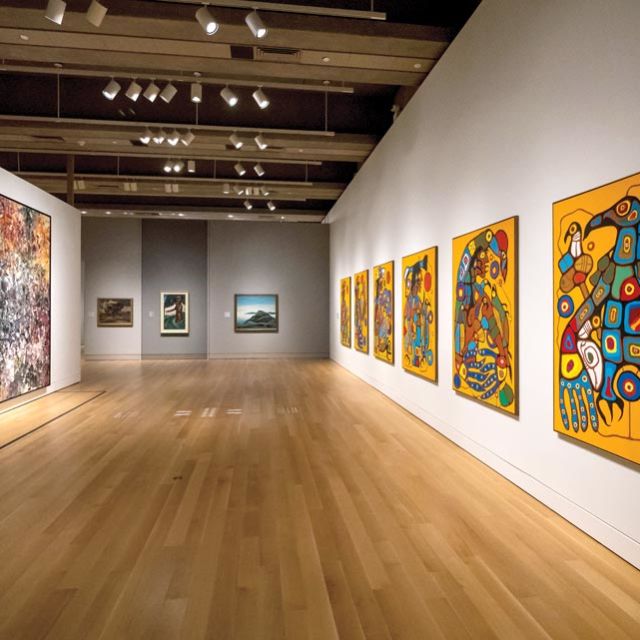Visit 5 Toronto cultural hotspots where you can experience traditional and contemporary visual and performance art by First Nations, Métis and Inuit artists.
– Written and researched by Clayton Windatt, Tara Nolan, Jennifer Krissilas and Yuki Hayashi
Indigenous art occupies a vital position within Canadian art. Indigenous people consist of diverse cultural groups, with strong identities within each First Nations, Métis and Inuit community, band and tribe—which extend into artists’ creative output.
When viewing Indigenous art, understanding the cultural context it was produced within will provide you with a deeper appreciation of the artist and their work.
Whether you’re looking to visit a museum, catch a show or stretch your legs while viewing outdoor art, here are five ways to discover Indigenous art in Toronto.
1. Tune in to ᑐᓴᕐᓂᑐᑦ TUSARNITUT! Music Born of the Cold
Named for “sounds that please the ear,” ᑐᓴᕐᓂᑐᑦ TUSARNITUT! Music Born of the Cold (May 20, 2023 to September 24, 2023) invites Royal Ontario Museum (ROM) visitors to experience the breadth and diversity of Inuit creative expression.
This includes the visual arts and musical genres of throat singing and drumming. Live musical performances will introduce visitors to contemporary artists who are reimagining these traditions for present-day fans.
The ROM is also home to four towering totem poles carved by members of the Nisga’a and Haida communities of the Pacific Northwest, and the Daphne Cockwell Gallery Dedicated to First Peoples Art & Culture, which includes over 1,000 works of art and cultural heritage.
2. Stroll around a 50-tonne Inukshuk
The Inukshuk is a sculptural figure that serves as a multifaceted guide to the Inuit, both practically and symbolically. The Waterfront area’s Toronto Inukshuk Park features a 50-tonne mountain rose granite version created by globally acclaimed artist Kellypalik Qimirpik, also of Cape Dorset.
Plan a scenic stroll (or an invigorating run along the Toronto Waterfront) to check out this iconic sight looming next to the Lake Ontario shoreline. One of North America’s largest Inukshuks, the structure stands about 9 m (30 ft) tall, with an arm span of 4.5 m (15 ft).

3. Spend the day at a major art gallery
The Art Gallery of Ontario (AGO) and, just north of the city, Kleinburg’s McMichael Canadian Art Collection (McMichael), showcase work by the most influential modern and contemporary Indigenous artists, including Ojibway visual artists Norval Morrisseau and Carl Beam.
Morrisseau pioneered the circa-1960s Woodland School of brightly coloured, stylized, symbolic art with thick lines connecting people, places and creatures together, while Beam examined themes of identity, colonization and resistance through a variety of media, including etchings, photography and collage.
Another major artist at the AGO and McMichael is Inuk artist Annie Pootoogook. Known for her ink and coloured pencil drawings, Pootoogook portrayed life in her Northern community of Cape Dorset, Nunavut (known as Kinngait in Inuktitut).
Her representations explore personal experiences, such as a woman experiencing domestic violence, and everyday occurrences, such as children watching television. Pootoogook’s work mixes humour and blunt representations of the disparities found in Indigenous life, making these scenes of “normal” life a point of confrontation.
Pootoogook’s work has been included in prestigious international group exhibitions, like Germany’s Documenta, and the permanent collection of the National Gallery of Canada.
The AGO’s Indigenous Collection is also home to more than 5,000 Inuit sculptures, prints and drawings, including Manasie Akpaliapik’s whalebone, ivory, stone, antler, baleen and horn sculpture, “Respecting the Circle,” which is one of the AGO’s most popular works on display.
The McMichael’s Inuit Art collection focuses on contemporary work, including a comprehensive collection of 100,000 drawings, prints and sculptures on long-term loan from Cape Dorset’s historic West Baffin Eskimo Co-Operative Limited artist group.
4. Catch a film screening
Launched in 2000, the imagineNATIVE Film & Media Arts Festival (October 17 to 29, 2023) is the world’s largest presenter of Indigenous screen content, showcasing national and global Indigenous-made film, video, audio and digital media each fall.
The Toronto International Film Festival (September 7 to 17, 2023) and year-round TIFF Bell Lightbox cinema both include Indigenous content in their regular lineups and special programming.
5. Dive into theatre and performance art
The oldest professional Indigenous theatre company in Canada, Native Earth Performing Arts has been presenting theatre, dance and multidisciplinary programming for nearly four decades. The organization is dedicated to presenting the artistic expression of the Indigenous experience in Canada.
Upcoming theatre performances include the youth-led Paprika Festival (May 16 to 22, 2023) and Aalaapi (June 8 to 10, 2023), a play that combines documentary and radio testimonies to immerse audiences in the daily lives of its five female protagonists from Nunavik, who share their lives between North and South.
Finally, if the stars align, check out the one-night-only 2-Spirit Cabaret, 7th Edition (June 6, 2023), a collaboration with the 2SLGBTQ+ focused Buddies In Bad Times Theatre, featuring a variety of performances by Indigiqueer artists.





